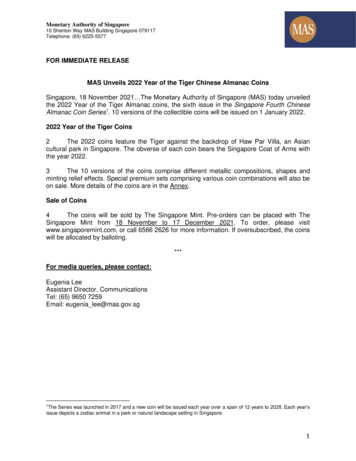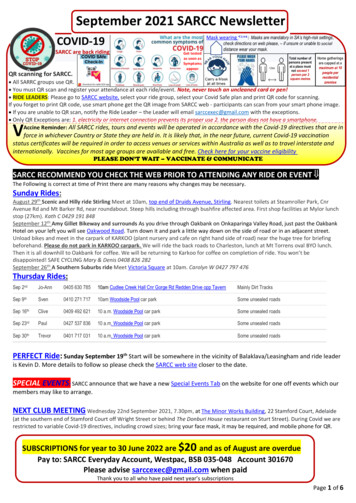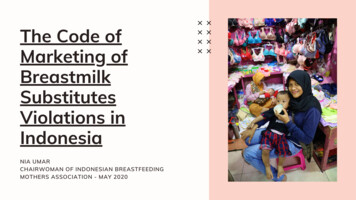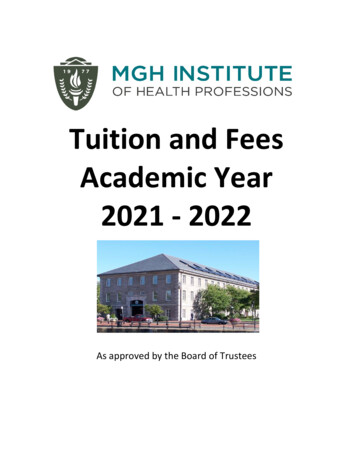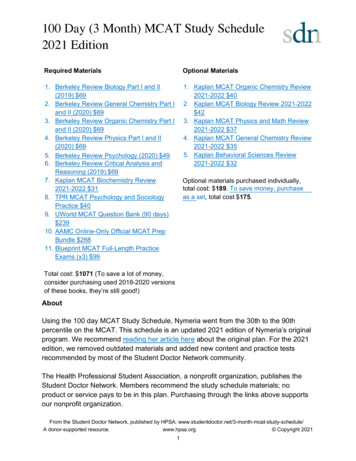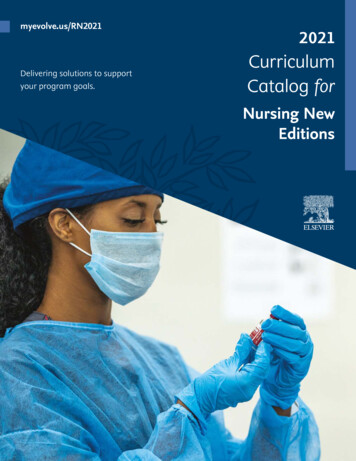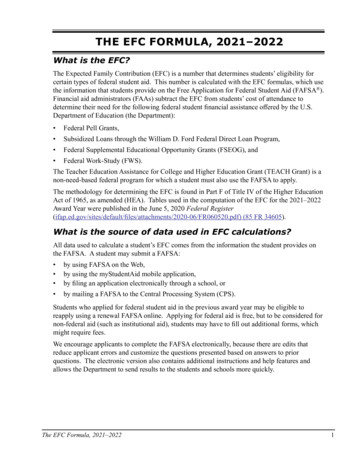
Transcription
THE EFC FORMULA, 2021–2022What is the EFC?The Expected Family Contribution (EFC) is a number that determines students’ eligibility forcertain types of federal student aid. This number is calculated with the EFC formulas, which usethe information that students provide on the Free Application for Federal Student Aid (FAFSA ).Financial aid administrators (FAAs) subtract the EFC from students’ cost of attendance todetermine their need for the following federal student financial assistance offered by the U.S.Department of Education (the Department): Federal Pell Grants, Subsidized Loans through the William D. Ford Federal Direct Loan Program, Federal Supplemental Educational Opportunity Grants (FSEOG), and Federal Work-Study (FWS).The Teacher Education Assistance for College and Higher Education Grant (TEACH Grant) is anon-need-based federal program for which a student must also use the FAFSA to apply.The methodology for determining the EFC is found in Part F of Title IV of the Higher EducationAct of 1965, as amended (HEA). Tables used in the computation of the EFC for the 2021–2022Award Year were published in the June 5, 2020 Federal ts/2020-06/FR060520.pdf) (85 FR 34605).What is the source of data used in EFC calculations?All data used to calculate a student’s EFC comes from the information the student provides onthe FAFSA. A student may submit a FAFSA: by using FAFSA on the Web,by using the myStudentAid mobile application,by filing an application electronically through a school, or by mailing a FAFSA to the Central Processing System (CPS).Students who applied for federal student aid in the previous award year may be eligible toreapply using a renewal FAFSA online. Applying for federal aid is free, but to be considered fornon-federal aid (such as institutional aid), students may have to fill out additional forms, whichmight require fees.We encourage applicants to complete the FAFSA electronically, because there are edits thatreduce applicant errors and customize the questions presented based on answers to priorquestions. The electronic version also contains additional instructions and help features andallows the Department to send results to the students and schools more quickly.The EFC Formula, 2021–20221
Who processes the FAFSA, and how are students notifiedof their EFC?The CPS receives the student’s FAFSA data, either electronically or on the paper application,and uses it to calculate an EFC. After the FAFSA has been processed, the CPS sends the studentan output document containing information about his or her application results. This document,which can be paper or electronic, is called a Student Aid Report (SAR). The SAR lists all theinformation from the application and indicates whether the application was complete and signed.If the application is complete and signed and there are no data conflicts, the SAR also includesthe student’s EFC. Students are instructed to carefully check the accuracy of the informationon the SAR. All schools listed on the student’s FAFSA receive application information andprocessing results in an electronic file called an Institutional Student Information Record (ISIR).Which EFC Formula Worksheet should be used?There are three regular formulas and a simplified version of each: Formula A, for dependent students; Formula B, for independent students without dependents other than a spouse; and Formula C, for independent students with dependents other than a spouse.The simplified versions of the EFC formula worksheets do not use assets in the calculation. Seepages 4 and 5 for information on which students qualify for the simplified formulas. Instructionsfor determining which applicants are eligible for the automatic zero EFC calculation are includedin each worksheet. See page 5 for more information on which students qualify for an automaticzero EFC.Formula A Worksheet.pages 9–12Simplified Formula A Worksheet .pages 13–16Formula B Worksheet.pages 17–18Simplified Formula B Worksheet.pages 19–20Formula C Worksheet.pages 21–22Simplified Formula C Worksheet.pages 23–24Tables.pages 25–29Note: Do not complete the shaded areas in the simplified worksheets;asset information is not required in the simplified formulas.2The EFC Formula, 2021–2022
What is the definition of an independent student?Because the EFC formula for a dependent student uses parental data and the two formulas forindependent students do not, the first step in calculating a student’s EFC is to determine his orher dependency status. For the 2021–2022 Award Year, a student is automatically determined tobe independent for federal student aid purposes if he or she meets one or more of the followingcriteria: The student was born before January 1, 1998. The student is married or separated (but not divorced) as of the date of the application. At the beginning of the 2021–2022 school year, the student will be enrolled in a master’s ordoctoral degree program (such as MA, MBA, MD, JD, PhD, EdD, or graduate certificate,etc.). The student is currently serving on active duty in the U.S. Armed Forces or is a NationalGuard or Reserves enlistee called into federal active duty for purposes other than training. The student is a veteran of the U.S. Armed Forces (see the definition in the box on page 4). The student has or will have one or more children who receive more than half of their supportfrom him or her between July 1, 2021, and June 30, 2022. The student has dependent(s) (other than children or spouse) who live with him or her andwho receive more than half of their support from the student, now and through June 30, 2022. At any time since the student turned age 13, both of the student’s parents were deceased, orthe student was in foster care or was a dependent or ward of the court. As determined by a court in the student’s state of legal residence, the student is now, or wasupon reaching the age of majority, an emancipated minor (that is, released from control byhis or her parent or guardian). As determined by a court in the student’s state of legal residence, the student is now, or wasupon reaching the age of majority, in legal guardianship. On or after July 1, 2020, the student was determined by a high school or school districthomeless liaison to be an unaccompanied youth who was homeless or was self-supportingand at risk of being homeless. On or after July 1, 2020, the student was determined by the director of an emergency shelteror transitional housing program funded by the U.S. Department of Housing and UrbanDevelopment to be an unaccompanied youth who was homeless or was self-supporting and atrisk of being homeless. At any time on or after July 1, 2020, the student was determined by a director of a runawayor homeless youth basic center or transitional living program to be an unaccompanied youthwho was homeless or was self-supporting and at risk of being homeless. The student is determined by the college financial aid administrator to be an unaccompaniedyouth who is homeless or is self-supporting and at risk of being homeless.For students who do not meet any of the above criteria but who have documented unusualcircumstances, an FAA can override their dependency status from dependent to independent. Forinformation about dependency overrides, see the Application and Verification Guide, which ispart of the Federal Student Aid Handbook and can be found on the IFAP Web site.The EFC Formula, 2021–20223
TERMS USED IN THE DEFINITION OF AN INDEPENDENT STUDENTLEGAL DEPENDENT. Any children of the student who receive more than halfof their support from the student (children do not have to live with the student),including a biological or adopted child. Also, any persons, other than a spouse, wholive with the student and receive more than half of their support from the student nowand will continue to receive more than half of their support from the student throughJune 30, 2022.VETERAN. A student who: (1) has engaged in active service in the U.S. ArmedForces (Army, Navy, Air Force, Marines, or Coast Guard), or has been a member ofthe National Guard or Reserves who was called to active duty for purposes other thantraining, or was a cadet or midshipman at one of the service academies, or attendeda U.S. military academy preparatory school, and (2) was released under a conditionother than dishonorable. A veteran is also a student who does not meet this definitionnow but will by June 30, 2022.Which students qualify for the simplified EFC formulas?The following criteria determine which students have their EFCs calculated by a simplifiedformula. Assets are not considered in the simplified EFC formulas.For the 2021–2022 Award Year, a dependent student qualifies for the simplified EFC formula ifboth (1), below, and (2), on the next page, are true:(1) Anyone included in the parents’ household size (as defined on the FAFSA) receivedbenefits during 2019 or 2020 from any of the designated means-tested federal benefitprograms: the Medicaid Program, the Supplemental Security Income (SSI) Program, theSupplemental Nutrition Assistance Program (SNAP), the Free and Reduced Price SchoolLunch Program, the Temporary Assistance for Needy Families (TANF) Program1, and theSpecial Supplemental Nutrition Program for Women, Infants, and Children (WIC);ORthe student’s parents: filed a 2019 IRS Form 1040, but did not file a Schedule 12, filed a tax form from a Trust Territory3, or were not required to file any income tax return;ORthe student’s parent is a dislocated worker.The TANF Program may have a different name in the student’s or student’s parents’ state.Applicants may also qualify if they only filed a Schedule 1 to report the following additions oradjustments to income: unemployment compensation, educator expenses, IRA deduction, student loaninterest deduction, Alaska Permanent Fund dividend, or virtual currency.3For qualifying for the simplified or automatic zero EFC calculations, the following 2019 incometax forms are considered for a Trust Territory: the income tax return required by the tax code of theCommonwealth of Puerto Rico, Guam, American Samoa, the U.S. Virgin Islands, the Republic of theMarshall Islands, the Federated States of Micronesia, or Palau.124The EFC Formula, 2021–2022
AND(2) The combined 2019 income of the student’s parents is 49,999 or less. For tax filers, use the parents’ adjusted gross income from the tax return to determineif income is 49,999 or less. For non-tax filers, use the income shown on the 2019 W-2 forms of both parents (plusany other earnings from work not included on the W-2s) to determine if income is 49,999 or less.For the 2021–2022 Award Year, an independent student qualifies for the simplified EFC formulaif both (1) and (2) below are true:(1) Anyone included in the student’s household size (as defined on the FAFSA) receivedbenefits during 2019 or 2020 from any of the designated means-tested federal benefitprograms: the Medicaid Program, the SSI Program, SNAP, the Free and Reduced PriceSchool Lunch Program, the TANF Program4, and WIC;ORthe student and student’s spouse (if the student is married) both filed a 2019 IRS Form 1040, but did not file a Schedule 15, filed a tax form from a Trust Territory6, or were not required to file any income tax return;ORthe student (or the student’s spouse, if any) is a dislocated worker.AND(2) The student’s (and spouse’s) combined 2019 income is 49,999 or less. For tax filers, use the student’s (and spouse’s) adjusted gross income from the taxreturn to determine if income is 49,999 or less. For non-tax filers, use the income shown on the student’s (and spouse’s) 2019 W-2forms (plus any other earnings from work not included on the W-2s) to determine ifincome is 49,999 or less.Which students qualify for an automatic zero EFCcalculation?Certain students are automatically eligible for a zero EFC. The requirements for receiving anautomatic zero EFC are the same as those for the simplified EFC calculation except for thesedifferences: The income threshold for the parents of dependent students and for independent students andtheir spouses is 27,000 or less (for an automatic zero EFC) instead of 49,999 or less (forthe simplified EFC calculation), and For independent students, those without dependents other than a spouse cannot receive anautomatic zero EFC.New for 2021-2022: The income threshold for an automatic zero EFC increased to 27,000 forthe 2021-2022 Award Year.See note 1 on page 4.See note 2 on page 4.6See note 3 on page 4.The EFC Formula, 2021–2022455
For the 2021–2022 Award Year, a dependent student automatically qualifies for a zero EFC ifboth (1) and (2) below are true:(1) Anyone included in the parents’ household size (as defined on the FAFSA) receivedbenefits during 2019 or 2020 from any of the designated means-tested federal benefitprograms: the Medicaid Program, the SSI Program, SNAP, the Free and Reduced PriceSchool Lunch Program, the TANF Program7, and WIC;ORthe student’s parents: filed a 2019 IRS Form 1040, but did not file a Schedule 18, filed a tax form from a Trust Territory9, or were not required to file any income tax return;ORthe student’s parent is a dislocated worker.AND(2) The combined 2019 income of the student’s parents is 27,000 or less. For tax filers, use the parents’ adjusted gross income from the tax return todetermine if income is 27,000 or less. For non-tax filers, use the income shown on the 2019 W-2 forms of both parents(plus any other earnings from work not included on the W-2s) to determine if incomeis 27,000 or less.An independent student with dependents other than a spouse automatically qualifies for azero EFC if both (1), below, and (2), on the next page, are true:Anyone included in the student’s household size (as defined on the FAFSA) receivedbenefits during 2019 or 2020 from any of the designated means-tested federal benefitprograms: the Medicaid Program, the SSI Program, SNAP, the Free and Reduced PriceSchool Lunch Program, the TANF Program10, and WIC;OR(1)the student and student’s spouse (if the student is married) both filed a 2019 IRS Form 1040, but did not file a Schedule 111, filed a tax form from a Trust Territory12, orwere not required to file any income tax return;ORthe student (or the student’s spouse, if any) is a dislocated worker.See note 1 on page 4.See note 2 on page 4.9See note 3 on page 4.10See note 1 on page 4.11See note 2 on page 4.12See note 3 on page 4.786The EFC Formula, 2021–2022
AND(2) The student’s (and spouse’s) combined 2019 income is 27,000 or less. For tax filers, use the student’s (and spouse’s) adjusted gross income from the taxreturn to determine if income is 27,000 or less. For non-tax filers, use the income shown on the student’s (and spouse’s) 2019 W-2forms (plus any other earnings from work not included on the W-2s) to determine ifincome is 27,000 or less.Note: An independent student without dependents other than a spouse is not eligible for anautomatic zero EFC.Why might a calculation of an EFC using these worksheetsdiffer from the EFC reported on a student’s SAR?When it appears that an applicant has reported inconsistent data, the CPS may make certainassumptions to resolve the inconsistency. These assumed values, which are reported on thestudent’s SAR, are used to calculate the student’s EFC. Therefore, in some cases, the EFCproduced by these worksheets may differ from the EFC produced by the CPS if the assumedvalues are not used.In addition, to help reconcile EFC Formula Worksheet calculations with those of the CPS, allcalculations should be carried to three decimal places and then rounded to the nearest wholenumbers. Round upward for results of .500 to .999, round downward for results of .001 to .499.Rounding should be performed so that the intermediate value that is the result of each step doesnot have any decimal digits.The EFC Formula, 2021–20227
WORKSHEETS AND TABLESNew for 2021-2022 – In an effort to simplify the guide, the tables were combined and movedto follow the worksheets at the end of the document.Dependent StudentsFormula A Worksheet. pages 9–12Simplified Formula A Worksheet. pages 13–16Independent Students Without Dependents Other than a SpouseFormula B Worksheet. pages 17–18Simplified Formula B Worksheet. pages 19–20Independent Students With Dependents Other than a SpouseFormula C Worksheet. pages 21–22Simplified Formula C Worksheet. pages 23–24TablesTable 1 – State and Other Tax Allowance(Formulas A [parents only] and C). page 25Table 2 – State and Other Tax Allowance(Formulas A [student only] and B). page 26Table 3 – Social Security Tax (Formulas A, B, and C). page 27Table 4 – Income Protection Allowance (Formula A). page 27Table 5 – Income Protection Allowance (Formula C). page 28Table 6 – Business/Farm Net Worth Adjustment(Formulas A [parents only], B, and C). page 28Table 7 – Education Savings and Asset Protection Allowance(Formulas A [parents only], B, and C). page 29Table 8 – Contribution from AAI (Formulas A and C). page 29Note: Do not complete the shaded areas in the simplified worksheets; asset information isnot required in the simplified formulas.8The EFC Formula, 2021–2022
2021–2022 EFC FORMULA A : DEPENDENT STUDENTPARENTS’ INCOME IN 2019AVAILABLE INCOME2. a. Parent 1 (father/mother/stepparent) incomeearned from work (FAFSA/SAR #86)2. b. Parent 2 (father/mother/stepparent) incomeearned from work (FAFSA/SAR #87) 3. Taxable income(If tax filers, enter the amount from line 1 above.If non-tax filers, enter the amount from line 2.)*5. Taxable and untaxed income(sum of line 3 and line 4) 6. Total additional financial information(total of FAFSA/SAR #91a through 91f) 7. TOTAL INCOME(line 5 minus line 6) May be a negative number. ALLOWANCES AGAINST PARENTS’ INCOME9.State and other tax allowance(Table 1) If negative, enter zero. 10. Parent 1 (father/mother/stepparent) SocialSecurity tax allowance (Table 3) 11. Parent 2 (father/mother/stepparent) SocialSecurity tax allowance (Table 3) 12. Income protection allowance (Table 4) 13. Employment expense allowance: Two working parents (Parents’ Marital Statusis “married” or “unmarried and both parentsliving together”): 35% of the lesser of theearned incomes, or 4,000, whichever is less One-parent families: 35% of earned income,or 4,000, whichever is less Two-parent families, one working parent:enter zero 14. TOTAL ALLOWANCES *STOP HERE (at line 3) if the following are true:Line 3 is 27,000 or less and The parents did not file a Schedule 1 with their IRS Form 1040 or they are notrequired to file any income tax return or Anyone included in the parents’ household size (as defined on the FAFSA)received benefits during 2019 or 2020 from any of the designated means-testedfederal benefit programs or Either of the parents is a dislocated worker.If these circumstances are true, the Expected Family Contribution is automaticallyzero.The EFC Formula, 2021–2022 15. AVAILABLE INCOME (AI)May be a negative number. PARENTS’ CONTRIBUTION FROM ASSETS17. Net worth of investments** (FAFSA/SAR #89) 2019 U.S. income tax paid (FAFSA/SAR #85)(tax filers only) If negative, enter zero.TOTAL ALLOWANCES (from line 14)16. Cash, savings, and checking (FAFSA/SAR #88)4. Total untaxed income and benefits:(total of FAFSA/SAR #92a through 92h)8.ATOTAL INCOME (from line 7)1. Parents’ adjusted gross income (FAFSA/SAR #84)If negative, enter zero.Total parents’ income earned from workREGULARWORKSHEETPage 1 If negative, enter zero.18. Net worth of business and/or investment farm (FAFSA/SAR #90)If negative, enter zero.19. Adjusted net worth of business/farm(Calculate using Table 6.) 20. Net worth (sum of lines 16, 17, and 19) 21. Education savings and assetprotection allowance (Table 7) 22. Discretionary net worth(line 20 minus line 21) 23. Asset conversion rate 24. CONTRIBUTION FROM ASSETSIf negative, enter zero. .12PARENTS’ CONTRIBUTIONAVAILABLE INCOME (AI) (from line 15)CONTRIBUTION FROM ASSETS (from line 24) 25. Adjusted available income (AAI)May be a negative number. 26. Total parents’ contribution from AAI(Calculate using Table 8.) If negative, enter zero.27. Number in college in 2021–2022(Exclude parents.) (FAFSA/SAR #73) 28. PARENTS’ CONTRIBUTION (standardcontribution for nine-month enrollment)*** If negative, enter zero.**Do not include the family’s home.***To calculate the parents’ contribution for other than nine-monthenrollment, see page 11.Continued on the next page.9
REGULARWORKSHEETPage 2ASTUDENT’S INCOME IN 2019STUDENT’S CONTRIBUTION FROM ASSETS29.Adjusted gross income (FAFSA/SAR #36)If negative, enter zero.30.Income earned from work (FAFSA/SAR #38)31.Taxable income(If tax filer, enter the amount from line 29 above.If non-tax filer, enter the amount from line 30.)32.Total untaxed income and benefits(total of FAFSA/SAR #44a through 44i) 33.Taxable and untaxed income(sum of line 31 and line 32) 34.Total additional financial information(total of FAFSA/SAR #43a through 43f) 35.TOTAL INCOME(line 33 minus line 34)May be a negative number.45. Cash, savings, and checking (FAFSA/SAR #40)46. Net worth of investments*(FAFSA/SAR #41) If negative, enter zero47. Net worth of business and/or investment farm(FAFSA/SAR #42) If negative, enter zero.48. Net worth (sum of lines 45 through 47) 49. Assessment rate .2050. STUDENT’S CONTRIBUTION FROM ASSETS EXPECTED FAMILY CONTRIBUTION PARENTS’ CONTRIBUTION(from line 28)ALLOWANCES AGAINST STUDENT INCOME36.2019 U.S. income tax paid (FAFSA/SAR #37)(tax filers only) If negative, enter zero.37.State and other tax allowance(Table 2) If negative, enter zero. 38.Social Security tax allowance (Table 3) 39.Income protection allowance 40.Allowance for parents’ negative Adjustedavailable income (If line 25 is negative, enterline 25 as a positive number in line 40.If line 25 is zero or positive, enter zero in line 40.)41.TOTAL ALLOWANCES6,970STUDENT’S CONTRIBUTION FROM AI(from line 44) STUDENT’S CONTRIBUTION FROM ASSETS(from line 50) 51. EXPECTED FAMILY CONTRIBUTION(standard contribution for nine-monthenrollment)** If negative, enter zero. *Do not include the student’s home.**To calculate the EFC for other than nine-month enrollment, see thenext page. STUDENT’S CONTRIBUTION FROM INCOMETOTAL INCOME (from line 35)TOTAL ALLOWANCES (from line 41) 42. Available income (AI) 43. Assessment of AI 44. STUDENT’S CONTRIBUTION FROM AIIf negative, enter zero. 10.50The EFC Formula, 2021–2022
Note: Use this additional page to prorate the EFC only if the student will be enrolled for other than nine months and only to determinethe student’s need for Campus-Based aid or a Federal Direct Subsidized Loan. Do not use this page to prorate the EFC for a FederalPell Grant or TEACH Grant. The EFC for the Federal Pell Grant Program is the nine-month EFC used in conjunction with the costof attendance to determine a Federal Pell Grant award from the Payment or Disbursement Schedule.REGULARWORKSHEETPage 3Calculation of Parents’ Contribution for a Student Enrolled LESS than Nine MonthsAA1. Parents’ contribution(standard contribution for nine-month enrollment, from line 28)A2. Divide by 9. A3. Parents’ contribution per month A4. Multiply by number of months of enrollment. A5. Parents’ contribution for LESS than nine-month enrollment 9Calculation of Parents’ Contribution for a Student Enrolled MORE than Nine MonthsB1. Parents’ adjusted available income (AAI) (from line 25—may be a negative number)B2. Difference between the income protection allowance for a family of four and a family of five,with one in college B3. Alternate parents’ AAI for more than nine-month enrollment (line B1 line B2) 5,380B4. Total parents’ contribution from alternate AAI (calculate using Table 8)B5. Number in college (FAFSA/SAR #73) B6. Alternate parents’ contribution for student (line B4 divided by line B5) B7. Standard parents’ contribution for the student for nine-month enrollment (from line 28) B8. Difference (line B6 minus line B7) B9. Divide line B8 by 12 months. B10. Parents’ contribution per month B11. Number of months student will be enrolled that exceeds nine B12. Adjustment to parents’ contributionfor months that exceed nine (multiply line B10 by line B11) B13. Standard parents’ contributionfor nine-month enrollment (from line 28) B14. Parents’ contribution for MORE than nine-month enrollment 12Calculation of Student’s Contribution from Available Income (AI) for a Student Enrolled LESS than Nine Months*C1. Student’s contribution from AI(standard contribution for nine-month enrollment, from line 44)C2. Divide by 9. C3. Student’s contribution from AI per month C4. Multiply by number of months of enrollment. C5. Student’s contribution from AI for LESS than nine-month enrollment 9*For students enrolled more than nine months, the standard contribution from AI is used (the amount from line 44).Use next page to calculate total EFC for enrollment periods other than nine months.The EFC Formula, 2021–202211
REGULARWORKSHEETPage 4ACalculation of Total Expected Family Contribution for Periods of Enrollment Other than Nine MonthsParents’ Contribution—use ONE appropriate amount from previous page: Enter amount from line A5 for enrollment periods less than nine months OR Enter amount from line B14 for enrollment periods greater than nine months.Student’s Contribution from Available Income—use ONE appropriate amount from previous page: Enter amount from line C5 for enrollment periods less than nine months OR Enter amount from line 44 for enrollment periods greater than nine months.12 Student’s Contribution from Assets Enter amount from line 50. Expected Family Contribution for periods of enrollment other than nine months The EFC Formula, 2021–2022
2021–2022 EFC FORMULA A : DEPENDENT STUDENTPARENTS’ INCOME IN 2019AVAILABLE INCOMEParents’ adjusted gross income (FAFSA/SAR #84)If negative, enter zero.2.a. Parent 1 (father/mother/stepparent) incomeearned from work (FAFSA/SAR #86)2.b. Parent 2 (father/mother/stepparent) incomeearned from work (FAFSA/SAR #87) 3. Taxable income(If tax filers, enter the amount from line 1 above.If non-tax filers, enter the amount from line 2.)*Total untaxed income and benefits:(total of FAFSA/SAR #92a through 92h) 5.Taxable and untaxed income(sum of line 3 and line 4) 6.Total additional financial information7.TOTAL INCOME(line 5 minus line 6) May be a negative number. ALLOWANCES AGAINST PARENTS’ INCOME8.2019 U.S. income tax paid (FAFSA/SAR #85)(tax filers only) If negative, enter zero.9.State and other tax allowance(Table 1) If negative, enter zero.TOTAL ALLOWANCES (from line 14) 15. AVAILABLE INCOME (AI)May be a negative number. PARENTS’ SETS16. Cash, savings, and checking (FAFSA/SAR #88)4.(total of FAFSA/SAR #91a through 91f) 17. Net worth of investments**(FAFSA/SAR #89)If negative, enter zero. 18. Net worth of business and/or investment farm(FAFSA/SAR #90) If negative, enter zero.19. Adjusted net worth of business/farm(Calculate using Table 6.) 20. Net worth (sum of lines 16, 17, and 19) 21. Education savings and assetprotection allowance (Table 7) 22. Discretionary net worth(line 20 minus line 21) 23. Asset conversion rate 24. CONTRIBUTION FROM ASSETSIf negative, enter zero. 10. Parent 1 (father/mother/stepparent) SocialSecurity tax allowance (Table 3) 11. Parent 2 (father/mother/stepparent) SocialSecurity tax allowance (Table 3) AVAILABLE INCOME (AI) (from line 15)12. Income protection allowance (Table 4) CONTRIBUTION FROM ASSETS (from line 24) 25. Adjusted available income (AAI)May be a negative number. 13. Employment expense allowance: Two working parents (Parents’ Marital Statusis “married” or “unmarried and both parentsliving together”): 35% of the lesser of theearned incomes, or 4,000, whichever is less One-parent families: 35% of earned income,or 4,000, whichever is less Two-parent families, one working parent: enter zero14. TOTAL ALLOWANCES *STOP HERE (at line 3) if the following are true:Line 3 is 27,000 or less and The parents did not file a Schedule 1 with their IRS Form 1040 or they arenot required to file any income tax return or Anyone included in the parents’ household size (as defined on the FAFSA)received benefits during 2019 or 2020 from any of the designated meanstested federal benefit programs or Either of the parents is a dislocated worker.If these circumstances are true, the Expected Family Contribution isautomatically zero.The EFC Formula, 2021–2022ATOTAL INCOME (from line 7)1.Total parents’ income earned from workSIMPLIFIEDWORKSHEETPage 1PARENTS’ CONTRIBUTION26. Total parents’ contribution from AAI(Calculate using Table 8.) If negative, enter zero.27. Number in college in 2021–2022(Exclude parents.) (FAFSA/SAR #73) 28. PARENTS’ CONTRIBUTION (standardcontribution for nine-month enrollment)***If negative, enter zero. **Do not include the family’s hom
The student was born before January 1, 1998. The student is married or separated (but not divorced) as of the date of the application. At the beginning of the 2021–2022 s
